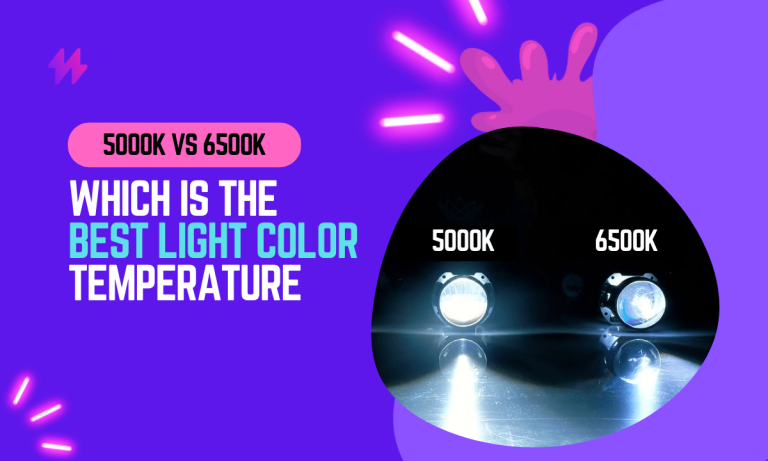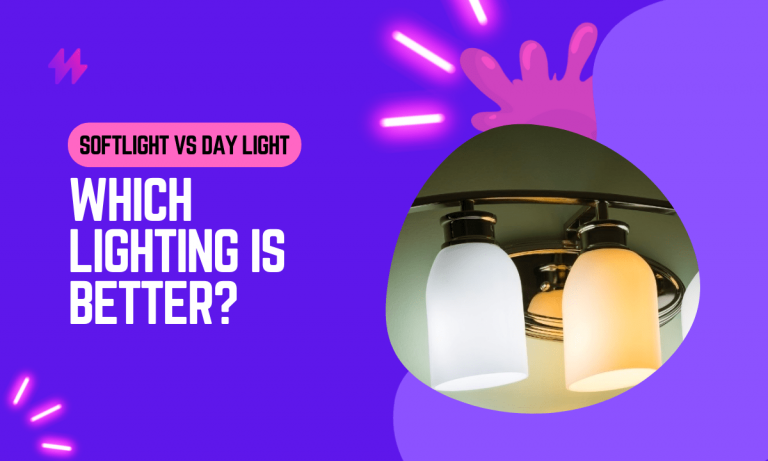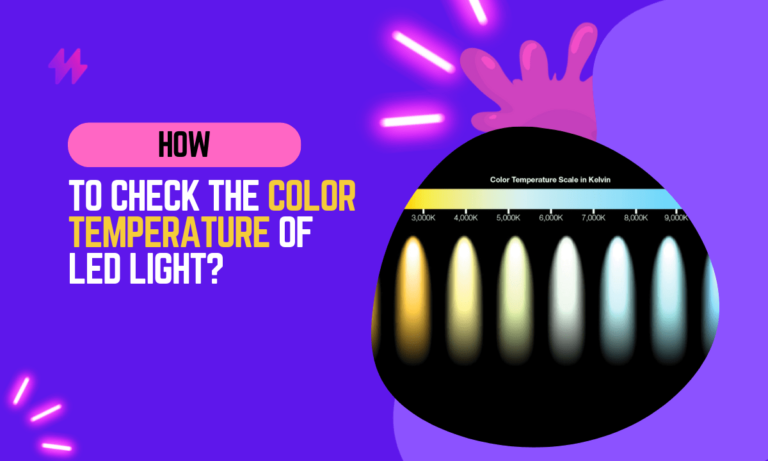How to Avoid Color Temperature Inconsistencies of LED lights
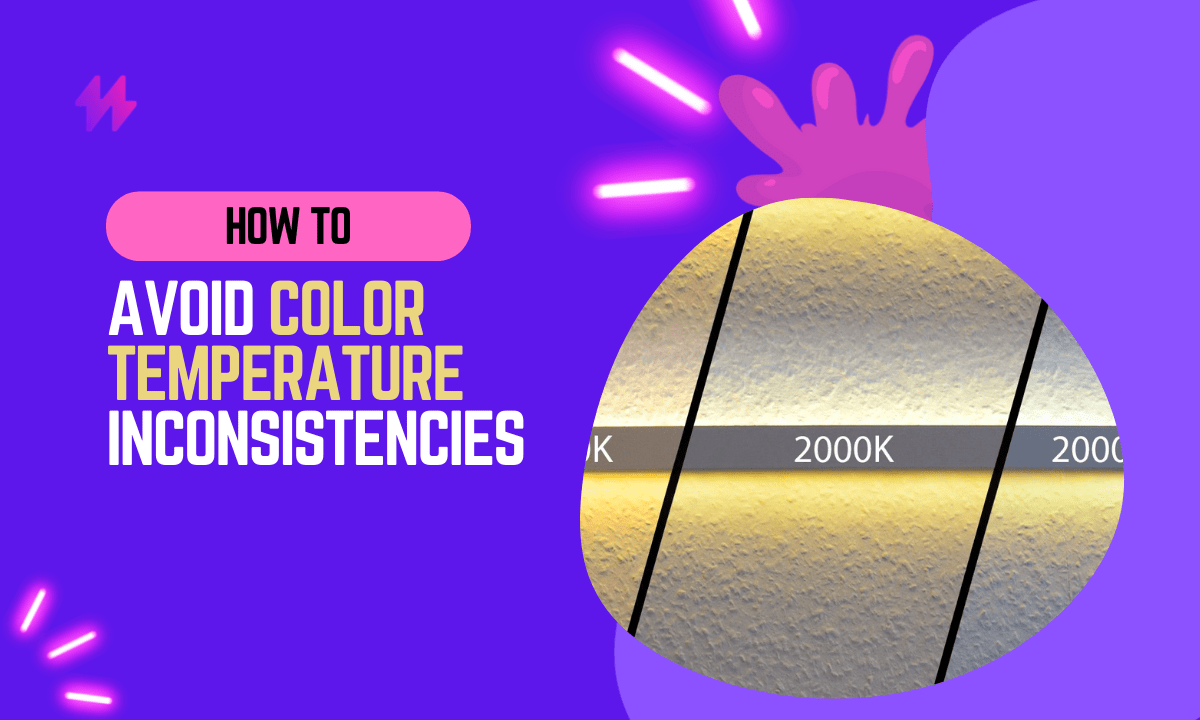
It’s no secret that LED lights are becoming more and more popular by the day. They’ve quickly replaced incandescent light bulbs as the go-to choice for a variety of reasons – they’re more energy efficient, longer lasting, and emit less heat.
One thing that often surprises people about LED lights is how different colors can look when emitted from the same LED lights. This inconsistency in color temperature is due to a number of factors, but can often be resolved through proper calibration. In this blog post, we’ll discuss what causes inconsistencies in color temperature, how to avoid them, and some tips for calibrating your LED lights.
The shift from traditional incandescent light to LED lamps has been beneficial for both energy savings and longevity, yet color inconsistency could lead to noticeable differences in illumination quality. It’s essential to pay attention to the specific color temperature values and ensure proper calibration for achieving the right color temperature in your lighting products. Keeping track of color tolerances and maintenance will help prevent color mismatches and ensure a consistent lighting experience across all your installed LED strip lights and other lamps.
How to Avoid Color Temperature Inconsistencies of LED Lights: Causes and Solutions
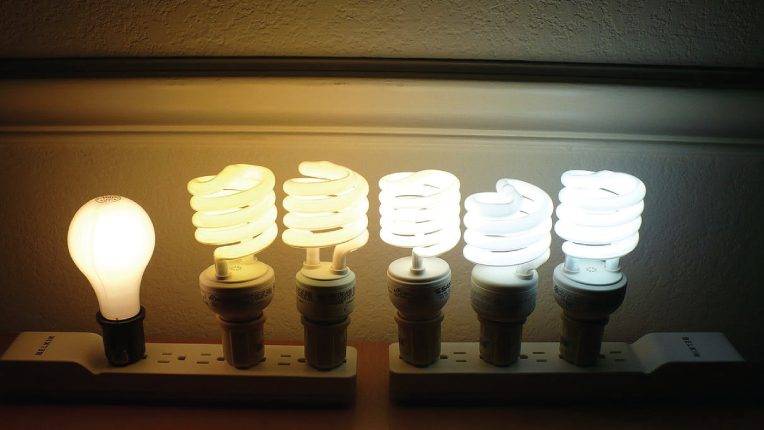
There are many reasons why the color temperature of LED lights might be different. Some of the reasons are:
Several factors can cause LED lights to exhibit different color temperatures, including variations in the manufacturing process and the presence of different LED emitters. To address color temperature requirements and avoid color mismatch issues, it’s advisable to use color measurement equipment and consult lighting experts when selecting lighting products.
- The light might be coming from different parts of the LED. This can cause some colors to be brighter than other colors.
- Some LED lights might not be calibrated correctly. This means that they might not be set to the same brightness or color temperature as other LED lights. You can avoid these inconsistencies by making sure that your LED lights are calibrated correctly and by choosing LEDs from the same batch.
- The surrounding environment can also affect the color temperature of LED lights. For example, if there is a lot of ambient light in the room, this will cause your LED lights to appear brighter and cooler than usual. Similarly, if you are looking at the LEDs from an angle or through a screen, this can cause discoloration and inconsistencies in color temperature.
- Finally, some LEDs may use materials that change their light over time. This can cause changes in color temperature even without any interference from the surrounding environment.
Avoiding Color Temperature Inconsistencies: Key Tips and Insights
In order to avoid color temperature inconsistencies with your LED lights, it’s important to take these factors into account and calibrate your LEDs accordingly.
One of the best ways to avoid color temperature inconsistencies with LED lights is to take a proactive approach and calibrate your LEDs regularly. This can be done by using specialized calibration tools or by working directly with an LED manufacturer to ensure that your LEDs are properly calibrated to the same standards.
Another important step you can take is to choose quality LED lights from reputable manufacturers. Avoid buying low-quality, off-brand LEDs that may not have been thoroughly tested or calibrated. By choosing well-made, high-quality LEDs from a trusted source, you can minimize the risk of inconsistencies in color temperature.
Finally, it’s important to consider your surrounding environment when using LED lights. Avoid exposing your LEDs to other sources of light or glare from screens, and make sure that they are not being viewed from an angle or through a screen. These simple steps can help you ensure that your LED lights are emitting consistent, high-quality light for years to come.
You may also like: 3000K vs 4000K Color Temperature Difference
In order to ensure optimal color consistency with your LED installations, it is crucial to monitor the **color temperature** and invest in quality **light sources**. By doing so, you can mitigate **color difference** issues and maintain a seamless lighting experience in your environment.
Calibration Tips for LED Lights: Ensuring Consistent Color Temperature
When calibrating LED lights, it’s important to use specialized tools and techniques that are designed specifically for LED lights. Some tips for calibrating LEDs include:
1. Avoid exposing your LEDs to other sources of light, as this can affect their color temperature.
2. Make sure that you are working with high-quality LEDs from reputable manufacturers, as these will be more consistently calibrated and easier to adjust if necessary. They will be able to provide specialized knowledge and guidance that can help you achieve optimal results with your LED lights.
3. Consider the surrounding environment when using your LEDs – try to keep them in a dark space or shield them from ambient light whenever possible.
4. When adjusting the brightness or color temperature of your LEDs, start by making small changes and taking measurements at each stage so that you can quickly identify and fix any problems.
Also read: 4000K vs 5000K, which Color Temperature is Best for Home Lighting
To enhance the color consistency of your LED lighting installation, it is advisable to closely monitor the **color temperature** and commit to regular **lights maintenance**. Avoiding potential **color differences** can significantly improve the overall ambiance of the space and provide a more enjoyable lighting experience.
Final Insights on Avoiding Color Temperature Inconsistencies: Tips for LED Calibration
In conclusion, managing and avoiding color temperature inconsistencies in LED lighting is crucial for achieving a harmonious and aesthetically pleasing lighting environment. Such inconsistencies can detract from the visual comfort of a space and may impact mood and functionality, depending on the setting. To ensure uniformity in LED lighting, it is essential to purchase LEDs from reputable manufacturers who provide detailed and accurate specifications about color temperature and color rendering index (CRI). It is also advisable to buy all the needed LED lights at once to avoid variations that can occur with different manufacturing batches. Ensuring that all LEDs used in a particular space are of the same color temperature is a key step in maintaining consistency.
Moreover, employing advanced lighting control systems that allow for fine-tuning and adjustments can help mitigate any minor inconsistencies that may arise over time or from unit to unit. These systems can adjust the output and color temperature dynamically to compensate for variations and ensure a consistent appearance across all fixtures. Regular maintenance checks and the recalibration of lighting systems also play a vital role in preserving the consistency of LED lights. By implementing these strategies, users can enjoy the full benefits of LED lighting technology, enhancing both the functionality and aesthetic appeal of their environments with reliable, consistent lighting solutions.
How To Avoid Color Temperature Inconsistencies Of LED Lights | Understanding Color Temperature Inconsistencies in LED Lights
Understanding color temperature inconsistencies in LED lights requires a deep dive into how light emits at various degrees Kelvin and its impact on overall ambiance. The International Commission on Illumination outlines color temperature as the characteristic of light sources that influence the hue of the light emitted. Variations may arise from using different lighting products such as LEDs, fluorescent lamps, or even decorative bulbs; these may not match with a consistent black-body radiator temperature, leading to noticeable color differences. To avoid color temperature inconsistencies of LED lights, it is crucial to consider factors like thermal radiation and chromaticity coordinates. Choosing LEDs that emit warm light output or cool LEDs with a standard color temperature can minimize issues like color shift, including magenta or green color shifts. Regular light installation checks, particularly for individual LEDs in configurations like ceiling lamps or light strips, help ensure that all fixtures maintain the same temperature, ultimately addressing potential color consistency problems.
How to Avoid Color Temperature Inconsistencies of LED lights | What is Color Temperature?
Color temperature refers to the hue of light emitted by a light source, measured in Kelvin (K). It plays a crucial role in how we perceive colour and is a vital factor for evaluating light products. A lighting manufacturer may create LEDs that emit light ranging from warm red-orange-yellow-white-blue color temperature to cooler blue tones. Understanding the concept of black-body radiators can help consumers choose the appropriate color temperature for their needs. By selecting LEDs closely matching the black-body color temperature, users can ensure a consistent lighting experience, avoiding the frustrating inconsistencies often associated with various lamp fixtures.
To avoid color temperature inconsistencies of LED lights, it is essential to consider factors such as color tuning and the specifications of different bulb styles. For example, the light emitted by decorative bulb style fixtures may differ from standard lamp fixtures like 4-ft fluorescent lamps or e12 lamp fixtures. Likewise, variations can occur between high-temperature lamps and a21 lamps. Ensuring a lighting match with minimal acceptable color variation is key to achieving a pleasing atmosphere. Keeping color deviation like magenta color shift or blue/yellow discrepancies in check will help maintain the actual color consistency across lighting setups, thereby enhancing overall functionality and aesthetics.
Common Causes of Inconsistencies
Variations in manufacturing processes can lead to noticeable discrepancies in colour temperature across different LED products. This inconsistency often stems from the quality of materials used and the specific methods employed during production. LEDs emit light at varying temperatures, causing visible color differences, especially in large installations or mixed lighting situations. Understanding how to avoid color temperature inconsistencies of LED lights requires careful consideration of the brand and batch chosen.
Environmental factors also play a significant role in creating inconsistent lighting. Temperature fluctuations can alter the performance of LEDs, with high temperatures frequently affecting light output and colour fidelity. For those seeking to maintain uniformity in their lighting design, it is crucial to recognize the environmental influences that impact how LEDs emit light. Employing strategies such as ensuring proper ventilation and monitoring temperature can help in mitigating these inconsistencies.
Importance of Consistent Color Temperature in Lighting
Consistent color temperature in lighting plays a crucial role in shaping the ambiance of a space and influencing emotions. Variations in light temperature can lead to inconsistent color perceptions, causing distractions and discomfort. For example, using different types of LED lights without considering their color temperature compatibility can create a jarring experience. Understanding how to avoid color temperature inconsistencies of LED lights is essential for achieving a harmonious environment. Whether in home settings or professional applications like photography, maintaining uniformity helps eliminate the issues caused by inconsistent color, ensuring that hues appear as intended. Proper selection and matching of light sources, such as hitlights, can significantly enhance the overall aesthetic appeal.
Impact on Mood and Environment
Lighting plays a crucial role in shaping our mood and overall environment. Proper color temperature can create a welcoming atmosphere, making spaces feel more comfortable and inviting. Understanding how to avoid color temperature inconsistencies of LED lights can greatly enhance the emotional impact of a room. A setting with consistent color temperature aids in creating desired moods, whether it be a calming sanctuary or a vibrant gathering space.
Color temperature also affects our productivity and focus levels. Bright, cool lighting can energize workspaces, while warmer tones are conducive to relaxation and leisure. By knowing how to avoid color temperature inconsistencies of LED lights, homeowners and business owners can tailor their lighting to meet the specific needs of the space. This thoughtful approach to lighting not only improves functionality but also contributes to a more harmonious living or working environment.
Implications for Photography and Videography
In photography and videography, consistent color temperature is crucial for achieving accurate and visually appealing results. Variations in color temperature can lead to unwanted color casts that distort the intended mood and tone of images or videos. To address these challenges, understanding how to avoid color temperature inconsistencies of LED lights is essential. Photographers and videographers must ensure that the lighting used is uniform across all scenes to maintain a cohesive look.
The choice of LED lights plays a significant role in the final output of visual media. Using lights with varying color temperatures can complicate post-production processes and affect the overall quality of the work. By incorporating strategies on how to avoid color temperature inconsistencies of LED lights, creators can streamline their workflow and produce more professional-grade content. This attention to detail not only enhances the viewer’s experience but also strengthens the impact of the storytelling.
Strategies for Selecting LED Lights Wisely
Selecting LED lights wisely involves a keen understanding of how to avoid color temperature inconsistencies of LED lights. First, it’s crucial to assess your specific needs, as different settings and tasks require varying color temperatures for optimal performance. This consideration helps in choosing fixtures that match the intended ambiance or functional requirements. Evaluating quality and brand reputation also plays a significant role, as reputable manufacturers often provide accurate color temperature specifications and consistent performance. By carefully considering these factors, one can effectively mitigate the risk of color temperature inconsistencies and enhance the overall lighting experience.
Choosing the Right Color Temperature for Your Needs
Selecting the right color temperature is crucial for achieving the desired ambiance in any setting. Understanding how to avoid color temperature inconsistencies of LED lights can help create a harmonious environment. For instance, warmer tones (around 2700K to 3000K) foster a cozy atmosphere, making them ideal for living rooms and bedrooms. Conversely, cooler temperatures (over 4000K) enhance focus and alertness, making them suitable for workspaces or kitchens.
It’s important to consider the intended use of the space when choosing color temperature. Different activities benefit from different lighting conditions, so knowing how to avoid color temperature inconsistencies of LED lights becomes essential. Establishing a consistent temperature across fixtures will help maintain a unified look. Test various samples in your environment to assess how they interact with existing decor and color schemes.
Evaluating Quality and Brand Reputation
Choosing LED lights from reputable brands can significantly reduce the risk of color temperature inconsistencies. Established companies often invest in research and quality control, ensuring their products meet specific standards. This attention to detail provides customers with more reliable lighting solutions, making it easier to maintain consistent color temperatures. Understanding how to avoid color temperature inconsistencies of LED lights begins with selecting products from manufacturers known for their commitment to quality.
Reviews and customer feedback play a vital role in evaluating brand reputation. Potential buyers should seek out information about a brand’s history, product performance, and customer support. Reading experiences from other users can help identify any recurring issues related to color temperature. By doing this research, you can make informed decisions that lead to a successful lighting setup, ultimately mastering how to avoid color temperature inconsistencies of LED lights.
Practical Techniques for Maintaining Color Consistency
Maintaining color consistency in LED lighting involves several practical techniques that can help ensure uniformity over time. Regular maintenance routines are essential; this includes cleaning light fixtures and replacing aging bulbs promptly. Understanding how to avoid color temperature inconsistencies of LED lights is vital, as environmental factors can significantly impact performance. For instance, operating LED lights in varying temperatures or humidity levels may alter their color output. Implementing a stable environment for your lighting setup is crucial. By consistently monitoring these aspects, users can effectively manage color temperature and enhance the overall quality of their lighting experience.
Regular Maintenance Routines
Establishing a consistent maintenance schedule is essential for how to avoid color temperature inconsistencies of LED lights. Regularly inspecting and cleaning light fixtures can prevent dust and debris build-up, which can alter the perceived color temperature. Dust accumulation can diffuse light unevenly, leading to variations that can disrupt the overall ambiance of a space.
Testing LED lights periodically ensures they are functioning optimally. Replace any bulbs that flicker or have noticeable color shifts. This proactive approach is a key element in how to avoid color temperature inconsistencies of LED lights. By addressing minor issues before they escalate, you maintain a more uniform lighting experience.
Environmental Factors to Consider
Ambient light can significantly influence the perceived color temperature of LED lights. It’s crucial to be aware of the surrounding environment when selecting and using these lights. Natural light sources, such as sunlight, can alter the way LED lighting appears, impacting its overall effectiveness. To understand how to avoid color temperature inconsistencies of LED lights, consider the time of day and the types of surfaces nearby, as they can reflect or absorb light, further complicating color perception.
Room color and decor also play roles in color consistency. Darker walls might absorb more light, resulting in a warmer feel, while lighter surfaces may reflect light, producing a cooler effect. How to avoid color temperature inconsistencies of LED lights hinges on making thoughtful design choices. Choosing the right wall colors and furnishings can help maintain a more stable color temperature throughout the space, ensuring that the lighting remains consistent and visually appealing.
Professional Solutions for Color Temperature Calibration
Calibration tools and equipment play a critical role in ensuring uniform color temperatures in LED lighting. Understanding how to avoid color temperature inconsistencies of LED lights requires precision instruments that can assess and adjust light output. Professional calibration services can utilize spectrometers and color meters to accurately measure the color temperature of lights and make necessary adjustments. These tools not only enhance visual consistency but also help maintain the desired ambiance in various settings. For those committed to achieving impeccable lighting, investing in professional solutions for calibration is essential in mitigating discrepancies and optimizing performance. Knowing how to avoid color temperature inconsistencies of LED lights can lead to a more enjoyable and effective visual experience.
Tools and Equipment for Calibration
Calibrating LED lights is essential for achieving consistent color temperature across different fixtures. Understanding how to avoid color temperature inconsistencies of LED lights involves utilizing specific tools such as color meters and spectrometers. These devices provide accurate readings of light output, allowing for precise adjustments to maintain desired color temperatures. Regularly using these tools ensures that lighting installations meet professional standards and create the intended atmosphere.
Choosing the right calibration equipment is crucial for anyone serious about lighting consistency. A good colorimeter can help measure the color temperature accurately, while software tools can assist in analyzing and adjusting settings effectively. Knowing how to avoid color temperature inconsistencies of LED lights can elevate your projects, whether in photography, videography, or interior design. Investing in quality calibration tools will lead to professional results and enhance the overall lighting experience.
Conclusion
Proper understanding and attention to detail can significantly enhance your experience with LED lighting. Knowing how to avoid color temperature inconsistencies of LED lights is essential for achieving a cohesive and inviting atmosphere in any space. By selecting lights with consistent color temperatures and conducting regular maintenance, individuals can effectively mitigate the common causes of discrepancies. Emphasizing quality and brand reputation during the selection process also plays a crucial role in maintaining harmony in lighting. Overall, being proactive in addressing these factors ensures that the intended ambiance is preserved and appreciated.




